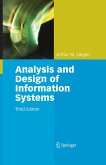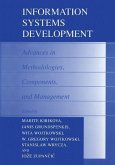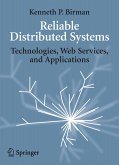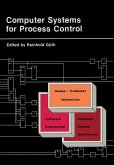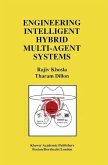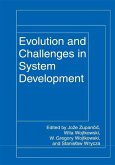Manfred Broy, Ketil Stølen
Specification and Development of Interactive Systems (eBook, PDF)
Focus on Streams, Interfaces, and Refinement
40,95 €
40,95 €
inkl. MwSt.
Sofort per Download lieferbar

20 °P sammeln
40,95 €
Als Download kaufen

40,95 €
inkl. MwSt.
Sofort per Download lieferbar

20 °P sammeln
Jetzt verschenken
Alle Infos zum eBook verschenken
40,95 €
inkl. MwSt.
Sofort per Download lieferbar
Alle Infos zum eBook verschenken

20 °P sammeln
Manfred Broy, Ketil Stølen
Specification and Development of Interactive Systems (eBook, PDF)
Focus on Streams, Interfaces, and Refinement
- Format: PDF
- Merkliste
- Auf die Merkliste
- Bewerten Bewerten
- Teilen
- Produkt teilen
- Produkterinnerung
- Produkterinnerung

Bitte loggen Sie sich zunächst in Ihr Kundenkonto ein oder registrieren Sie sich bei
bücher.de, um das eBook-Abo tolino select nutzen zu können.
Hier können Sie sich einloggen
Hier können Sie sich einloggen
Sie sind bereits eingeloggt. Klicken Sie auf 2. tolino select Abo, um fortzufahren.

Bitte loggen Sie sich zunächst in Ihr Kundenkonto ein oder registrieren Sie sich bei bücher.de, um das eBook-Abo tolino select nutzen zu können.
A mathematical and logical foundation for the specification and development of interactive systems based on a model that describes systems in terms of their input/output behavior. Based on this model, the authors build a basic method, called FOCUS, that enables interactive systems to be described by characterizing their histories of message interaction. The book progresses from an introduction and guided tour of FOCUS through streams, specifications and their properties, and behavioral, interface, and conditional refinements.
- Geräte: PC
- ohne Kopierschutz
- eBook Hilfe
- Größe: 25.77MB
Andere Kunden interessierten sich auch für
![Analysis and Design of Information Systems (eBook, PDF) Analysis and Design of Information Systems (eBook, PDF)]() Arthur M. LangerAnalysis and Design of Information Systems (eBook, PDF)40,95 €
Arthur M. LangerAnalysis and Design of Information Systems (eBook, PDF)40,95 €![Information Systems Development (eBook, PDF) Information Systems Development (eBook, PDF)]() Information Systems Development (eBook, PDF)40,95 €
Information Systems Development (eBook, PDF)40,95 €![Reliable Distributed Systems (eBook, PDF) Reliable Distributed Systems (eBook, PDF)]() Kenneth BirmanReliable Distributed Systems (eBook, PDF)65,95 €
Kenneth BirmanReliable Distributed Systems (eBook, PDF)65,95 €![Architecture Description Languages (eBook, PDF) Architecture Description Languages (eBook, PDF)]() Architecture Description Languages (eBook, PDF)73,95 €
Architecture Description Languages (eBook, PDF)73,95 €![Computer Systems for Process Control (eBook, PDF) Computer Systems for Process Control (eBook, PDF)]() Reinhold GüthComputer Systems for Process Control (eBook, PDF)40,95 €
Reinhold GüthComputer Systems for Process Control (eBook, PDF)40,95 €![Engineering Intelligent Hybrid Multi-Agent Systems (eBook, PDF) Engineering Intelligent Hybrid Multi-Agent Systems (eBook, PDF)]() Rajiv KhoslaEngineering Intelligent Hybrid Multi-Agent Systems (eBook, PDF)113,95 €
Rajiv KhoslaEngineering Intelligent Hybrid Multi-Agent Systems (eBook, PDF)113,95 €![Evolution and Challenges in System Development (eBook, PDF) Evolution and Challenges in System Development (eBook, PDF)]() Evolution and Challenges in System Development (eBook, PDF)161,95 €
Evolution and Challenges in System Development (eBook, PDF)161,95 €-
-
-
A mathematical and logical foundation for the specification and development of interactive systems based on a model that describes systems in terms of their input/output behavior. Based on this model, the authors build a basic method, called FOCUS, that enables interactive systems to be described by characterizing their histories of message interaction. The book progresses from an introduction and guided tour of FOCUS through streams, specifications and their properties, and behavioral, interface, and conditional refinements.
Dieser Download kann aus rechtlichen Gründen nur mit Rechnungsadresse in A, B, BG, CY, CZ, D, DK, EW, E, FIN, F, GR, HR, H, IRL, I, LT, L, LR, M, NL, PL, P, R, S, SLO, SK ausgeliefert werden.
Produktdetails
- Produktdetails
- Verlag: Springer US
- Seitenzahl: 348
- Erscheinungstermin: 6. Dezember 2012
- Englisch
- ISBN-13: 9781461300915
- Artikelnr.: 44177418
- Verlag: Springer US
- Seitenzahl: 348
- Erscheinungstermin: 6. Dezember 2012
- Englisch
- ISBN-13: 9781461300915
- Artikelnr.: 44177418
- Herstellerkennzeichnung Die Herstellerinformationen sind derzeit nicht verfügbar.
1. Introduction.- 1.1 Systems.- 1.2 Specifications.- 1.3 Refinement.- 1.4 Application Domains.- 1.5 Development Process and Methodology.- 1.6 Rationale of Focus.- 1.7 Overview of the Book.- 1.8 How the Book Should Be Read.- 2. A Guided Tour.- 2.1 Plan for the Tour.- 2.2 Station 1: Unbounded Buffer.- 2.3 Station 2: Unbounded Lossy Buffer.- 2.4 Station 3: Driver.- 2.5 Station 4: Composite Specifications.- 2.6 Station 5: Time-Sensitive Buffer.- 2.7 Station 6: Timed Lossy Buffer.- 2.8 Station 7: Timed Driver.- 2.9 Station 8: Timed Composite Specification.- 3. Basics.- 3.1 Sets.- 3.2 Tuples.- 3.3 Functions.- 3.4 Types.- 3.5 Logic.- 4. Streams.- 4.1 Formal Definition of Streams.- 4.2 Basic Operators on Streams.- 4.3 Additional Operators on Streams.- 4.4 Formal Definition of Timed Streams.- 4.5 Operators on Timed Streams.- 5. Specifications.- 5.1 Classification of Specifications.- 5.2 Elementary Specifications.- 5.3 Composite Specifications.- 5.4 Black-Box and Glass-Box Views.- 5.5 Parameterized Specifications.- 5.6 Sheafs and Replications.- 6. Examples.- 6.1 Alternating Bit Protocol.- 6.2 Steam Boiler.- 6.3 Memory Components.- 7. Properties of Specifications.- 7.1 Safety and Liveness Properties.- 7.2 Realizability.- 7.3 Causality for Specifications.- 8. Equational Specification of State Transitions.- 8.1 I/O Transitions.- 8.2 Local States.- 8.3 Control States.- 8.4 Oracles.- 9. Access Control System.- 9.1 System Architecture.- 9.2 Functional Properties of the Controllers.- 9.3 Introducing Exception Handling.- 9.4 Imposing Timing Constraints.- 10. Tables and Diagrams.- 10.1 State Transition Tables.- 10.2 State Transition Diagrams.- 10.3 Semantics of State Transition Tables and Diagrams.- 11. Abracadabra Protocol.- 11.1 Informal Specification.- 11.2 Formalization.- 12. A/G Specifications.- 12.1 Simple Examples.- 12.2 Semantics.- 12.3 More Examples.- 13. Memory with Locking.- 13.1 Black-Box Description.- 13.2 Distributed Implementation.- 14. Refinement.- 14.1 Behavioral Refinement.- 14.2 Interface Refinement.- 14.3 Conditional Refinement.- 14.4 Verification.- 14.5 Glass-Box Refinement.- 14.6 Development Method.- 15. Behavioral Refinement.- 15.1 Definition.- 15.2 Simple Examples.- 15.3 Logical Properties.- 15.4 More Examples.- 15.5 Synchronizing the Communication.- 16. Interface Refinement.- 16.1 Definition.- 16.2 A Priming Convention for Channel Identifiers.- 16.3 Simple Examples.- 16.4 Methodological Issues.- 16.5 Logical Properties.- 16.6 More Examples.- 16.7 Generalizing Interface Refinement.- 17. Conditional Refinement.- 17.1 Definition.- 17.2 Simple Examples.- 17.3 Logical Properties.- 17.4 More Examples.- 18. Final Remarks.- 18.1 How Our Approach Generalizes.- 18.2 What We Did Not Cover.- A. Operators for Stream Tuples.- A.l Generalized Operators.- A.2 Tuple Filtering Operator.- A.3 Timed Filtering Operator.- B. Glossary of Terms.- B.l Sets.- B.2 Tuples.- B.3 Functions.- B.4 Types.- B.5 Logic.- B.6 Arithmetics.- B.7 Streams.- B.8 Tuples of Streams.- B.9 Specifications.- B.10 Strategies.
1. Introduction.- 1.1 Systems.- 1.2 Specifications.- 1.3 Refinement.- 1.4 Application Domains.- 1.5 Development Process and Methodology.- 1.6 Rationale of Focus.- 1.7 Overview of the Book.- 1.8 How the Book Should Be Read.- 2. A Guided Tour.- 2.1 Plan for the Tour.- 2.2 Station 1: Unbounded Buffer.- 2.3 Station 2: Unbounded Lossy Buffer.- 2.4 Station 3: Driver.- 2.5 Station 4: Composite Specifications.- 2.6 Station 5: Time-Sensitive Buffer.- 2.7 Station 6: Timed Lossy Buffer.- 2.8 Station 7: Timed Driver.- 2.9 Station 8: Timed Composite Specification.- 3. Basics.- 3.1 Sets.- 3.2 Tuples.- 3.3 Functions.- 3.4 Types.- 3.5 Logic.- 4. Streams.- 4.1 Formal Definition of Streams.- 4.2 Basic Operators on Streams.- 4.3 Additional Operators on Streams.- 4.4 Formal Definition of Timed Streams.- 4.5 Operators on Timed Streams.- 5. Specifications.- 5.1 Classification of Specifications.- 5.2 Elementary Specifications.- 5.3 Composite Specifications.- 5.4 Black-Box and Glass-Box Views.- 5.5 Parameterized Specifications.- 5.6 Sheafs and Replications.- 6. Examples.- 6.1 Alternating Bit Protocol.- 6.2 Steam Boiler.- 6.3 Memory Components.- 7. Properties of Specifications.- 7.1 Safety and Liveness Properties.- 7.2 Realizability.- 7.3 Causality for Specifications.- 8. Equational Specification of State Transitions.- 8.1 I/O Transitions.- 8.2 Local States.- 8.3 Control States.- 8.4 Oracles.- 9. Access Control System.- 9.1 System Architecture.- 9.2 Functional Properties of the Controllers.- 9.3 Introducing Exception Handling.- 9.4 Imposing Timing Constraints.- 10. Tables and Diagrams.- 10.1 State Transition Tables.- 10.2 State Transition Diagrams.- 10.3 Semantics of State Transition Tables and Diagrams.- 11. Abracadabra Protocol.- 11.1 Informal Specification.- 11.2 Formalization.- 12. A/G Specifications.- 12.1 Simple Examples.- 12.2 Semantics.- 12.3 More Examples.- 13. Memory with Locking.- 13.1 Black-Box Description.- 13.2 Distributed Implementation.- 14. Refinement.- 14.1 Behavioral Refinement.- 14.2 Interface Refinement.- 14.3 Conditional Refinement.- 14.4 Verification.- 14.5 Glass-Box Refinement.- 14.6 Development Method.- 15. Behavioral Refinement.- 15.1 Definition.- 15.2 Simple Examples.- 15.3 Logical Properties.- 15.4 More Examples.- 15.5 Synchronizing the Communication.- 16. Interface Refinement.- 16.1 Definition.- 16.2 A Priming Convention for Channel Identifiers.- 16.3 Simple Examples.- 16.4 Methodological Issues.- 16.5 Logical Properties.- 16.6 More Examples.- 16.7 Generalizing Interface Refinement.- 17. Conditional Refinement.- 17.1 Definition.- 17.2 Simple Examples.- 17.3 Logical Properties.- 17.4 More Examples.- 18. Final Remarks.- 18.1 How Our Approach Generalizes.- 18.2 What We Did Not Cover.- A. Operators for Stream Tuples.- A.l Generalized Operators.- A.2 Tuple Filtering Operator.- A.3 Timed Filtering Operator.- B. Glossary of Terms.- B.l Sets.- B.2 Tuples.- B.3 Functions.- B.4 Types.- B.5 Logic.- B.6 Arithmetics.- B.7 Streams.- B.8 Tuples of Streams.- B.9 Specifications.- B.10 Strategies.

